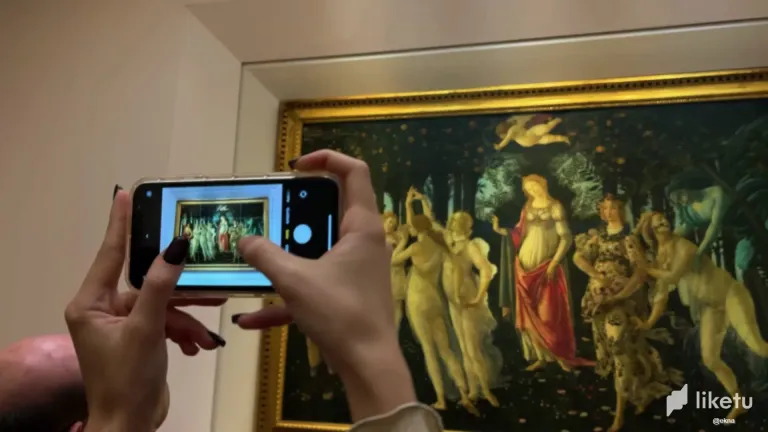









The Uffizi is quite a complex place. But this is mostly due to the chaos and the crowds, the flow of people... I haven't seen so many people in the galleries for a long time. It's almost impossible to walk in front of the paintings. There's a sense of rush.
I’ve always wondered, why do so many people want to come here? Why do they rush through the gallery rooms, barely stopping to look at any painting for a long time? What do they take away from the Uffizi? Social media photos?
The most disturbing thing in the gallery is the lack of signage and any explanations. We almost missed a floor that had masterpieces by Titian and other artists. So I would recommend visiting all the floors if you go.
The stairs and elevator go down from the upper floors to the lower ones, but there is no direct access to the center of the exhibit. After going up and down twice, we were told that the central floor was accessible from the inside. We had to enter the gallery itself.
There is an audio guide, but it's only available in exchange for leaving your ID or passport. There are plenty of guides and groups, but I didn’t want to listen to others praises, especially since I already knew most of the works from prints. We explored at our own pace, stopping where we thought necessary, without hurrying, resting occasionally.
I bought the tickets online. But later I found out that a group from London was selling tickets. Beware of these cowboys. They work for all kinds of wrong companies. Tickets could also be bought at the entrance, where there was no line at all.
It was wonderful to encounter the masterpieces and I was happy with my experience of art. Art is stronger than any kind of unpleasant little things.
I believe that everyone who sets foot in Florence has at least heard of the Uffizi gallery. There are many people who want to see the desired treasures of the Renaissance. The arrangements in the Uffizi gallery’s halls rarely change. The most popular rooms are always narrow and crowded and it feels like it should be that way.
However, in recent years the walls and paintings in the rooms have been moved, which has resulted in very successful outcomes and benefited everyone. Under the leadership of Aike Schmidt, a new Room 41 or the Raphael and Michelangelo Room was created.
Two enormous portraits of the Florentine merchants Angelo Doni and his wife Maddalena Strozzi were taken from the Palazzo Pitti. Meanwhile these paintings were transported to the Uffizi by museum staff via the Vasari Corridor, which is about one kilometer long.
The Doni family portraits are now placed in large glass display cases, accessible from all sides. You can surround the paintings and enhance the impact by examining the mythological scenes on the back panels. Here there are allegorical drawings by an artist from Raphael’s workshop, wishing young couples to have many children.
The portraits are displayed alongside Michelangelo's Holy Family, known as the Doni Tondo. This work is Michelangelo's only large completed painting that has survived to the present, aside from the Sistine Chapel. In this painting everything. The unexpected arrangement of the figures, the painting techniques unique to Michelangelo, the unusual frame and the mysterious naked male figures in the background, highlights the uniqueness of his genius. Strangely Maria is sitting on the grass instead of a throne. Who are they handing the child to? Why is Joseph placed higher than Maria? How did Michelangelo make the figures appear like marble statues? He was a genius.
In Room 41 a rare magical moment from the early years of the 16th century is captured, when Florence was the cultural and artistic center of the world. This period was also unique in Florence’s history. The Medici family had not ruled continuously for three hundred years between 1434 and 1737. Between 1498 and 1512, Florence was a republic and the Medici family was in exile.
Doni had replaced the Medici. He was the only patron (aside from a few Roman popes) for whom Michelangelo and Raphael worked. The Doni Tondo and the double portrait of the Doni family were both created during a year when the two artists were in Florence.
In the Raphael and Michelangelo Room, the gallery offers visitors the chance to hear a conversation between the geniuses of the past. Aike Schmidt simply stated at the opening of the room: In this room, the viewer will understand the history of art.
And I must mention that the paintings are displayed in ultra-transparent and incredibly durable glass showcases that would not even get scratched if a bicycle were thrown at them. The showcases support a microclimate and any anomalies are monitored in real-time and immediately reported to the curator's phone.
It may take some time to understand the vastness and complexity of the Uffizi as a whole. But in the end it seems impossible not to be in awe of this immense reflection of art and history.
For the best experience view this post on Liketu


